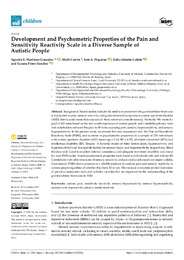Título :
Development and Psychometric Properties of the Pain and
Sensitivity Reactivity Scale in a Diverse Sample of
Autistic People |
Autor :
Martínez-González, Agustín Ernesto
Cervin, Matti
Piqueras, Jose A 
Infante Cañete, Lidia
Pérez-Sánchez, Susana |
Editor :
MDPI |
Departamento:
Departamentos de la UMH::Psicología de la Salud |
Fecha de publicación:
2024 |
URI :
https://hdl.handle.net/11000/36191 |
Resumen :
Abstract: Background: Recent studies indicate the need to examine how the gut microbiota–brain axis
is implicated in pain, sensory reactivity and gastro-intestinal symptoms in autism spectrum disorder
(ASD), but no scale exists that assesses all these constructs simultaneously. Methods: We created a
pool of 100 items based on the real-world experience of autistic people, and a multidisciplinary team
and stakeholders reduced this pool to 50 items assessing pain, sensory hypersensitivity, and sensory
hyposensitivity. In the present study, we present this new assessment tool, the Pain and Sensitivity
Reactivity Scale (PSRS), and examine its psychometric properties in a sample of 270 individuals
with autism spectrum disorder (ASD; mean age = 9.44, SD = 4.97), of which almost half (45%) had
intellectual disability (ID). Results: A factorial model of three factors (pain, hyporeactivity, and
hyperreactivity) and five specific factors for sensory hypo- and hyperreactivity, respectively, fitted
the data well. Good to excellent internal consistency and adequate test–retest reliability was found
for most PSRS scales. Sound psychometric properties were found in individuals with and without ID.
Correlations with other measures of sensory sensitivity and pain indicated sound convergent validity.
Conclusions: PSRS shows promise as a reliable measure to analyze pain and sensory reactivity in
autistic people regardless of whether they have ID or not. The measure overcomes several limitations
of previous assessment tools and includes variables that are important for the understanding of the
gut microbiota–brain axis in ASD.
|
Palabras clave/Materias:
autism
pain
sensitivity reactivity
sensory hyporeactivity
sensory hyperreactivity
sensory-over responsivity
sensory-under reactivity |
Área de conocimiento :
CDU: Filosofía y psicología: Psicología |
Tipo de documento :
info:eu-repo/semantics/article |
Derechos de acceso:
info:eu-repo/semantics/openAccess
Attribution-NonCommercial-NoDerivatives 4.0 Internacional |
DOI :
https://doi.org/10.3390/ children11121562 |
Publicado en:
Children 2024, 11,
1562. |
Aparece en las colecciones:
Artículos- Psicología de la Salud
|
 La licencia se describe como: Atribución-NonComercial-NoDerivada 4.0 Internacional.
La licencia se describe como: Atribución-NonComercial-NoDerivada 4.0 Internacional.
.png)
